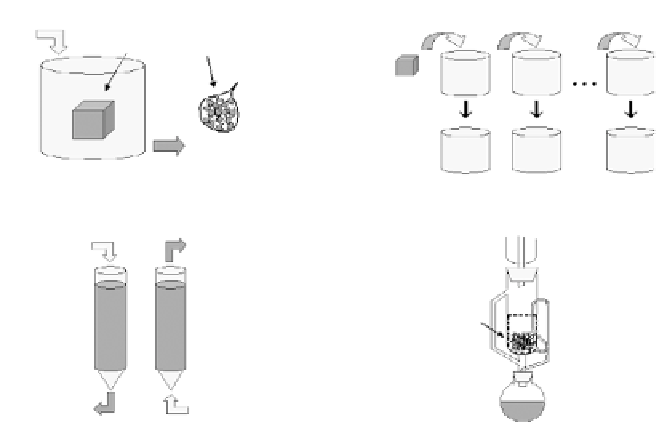Environmental Engineering Reference
In-Depth Information
Δ
t
1
Δ
t
2
Δ
t
n
leachant
1 sample
monolithic
sample
granular
sample
A
1
A
2
A
n
n
chemical
analyses
L
1
L
2
L
n
leachate
a)
b)
Condenser
C
leachant
leachate
siphon
granular or
monolithic
sample
solvent
vapor
return
down-flow
simulates
rainfall
up-flow
minimizes
channeling,
pore
plugging
Reaction
Vessel
A
Leachate
Reservoir
B
leachate
leachant
c)
d)
FIGURE 10.3
Schematic representations of mass-transport rate tests: a) flow-around test, b)
tank leach test, c) flow-through column test, and d) Soxhlet testing apparatus.
leachant (Figure 10.3b). At the end of each contact time, the sample is removed and
placed in a bath of fresh leachant for the subsequent leaching interval. Leachates
are analyzed and the results are reported as mean flux (i.e., mass per unit surface
area releases over the
i
th release interval) or cumulative release (i.e., total mass
release per surface area over a summation of leaching intervals).
All of the tank leaching tests shown in Table 10.2 specify DI water as the leaching
solution; however, some published research for S/S materials have used dilute inor-
ganic or organic acids,
140,192-195
buffered DI water using bubbled gases,
196-198
DI water
with ionic amendments,
195,199,200
or site-specific groundwater.
172
Although the typical
form of the subject material is monolithic, granular materials may be tested in a
similar manner after compaction into testing molds using a modified proctor com-
paction. For example, the MT002.1 (Mass Transport from Compacted Granular
Materials Test)
5
has been designed to represent cases where granular wastes may be
compressed into consolidated form at lower hydraulic conductivity than the sur-
rounding fill.
9
Considerable flexibility is offered by tank leaching tests in that leaching periods
may be easily interspersed with conditioning outside of the leaching environment
(e.g., period of storage or drying in gaseous atmosphere). This technique is especially
advantageous for durability assessment of cement-based materials, since many deg-
radation mechanisms, such as drying shrinkage, carbonation, and reinforcement
corrosion, are associated with the drying process. In recent research, storage of
portland cement mortar under constant atmospheric conditions has been used to
assess the process of matrix drying
148
as well as the effects of gradient relaxation
199,200
and carbonation
170
on the release of major constituents (Ca, Na, K) and trace con-
taminants (As, Cd, Cu, Pb, Zn).

Search WWH ::

Custom Search